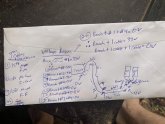Westy Travels
New Member
- Joined
- May 23, 2020
- Messages
- 1
Two questions:
1) In Will's book, he says on page 63, "It is preferable to have all MC4 connectors and branch connectors located on the roof. MC4 connectors should never be inside your vehicle." (Italics are mine.) Why? Will doesn't say! He just says NEVER.
Why can't I have a short dongle coming from my Victron solar charge controller and just snap in the MC4 connectors to whichever solar panel I want? I have two solar panels: a glass 100 watt Renogy on the roof of my VW Westfalia and a collapsible 110 watt panel from GoWesty that forced me to buy a Greeley SAE to MC4 connector. Having the MC4s in my van works well for my dual setup, especially with the Greeley dongle that I can switch in or out depending on which panel or panels I'm running.
2. I haven't heard anyone say it's bad to daisy chain MC4 connectors. I have the Renogy MC4 connectors on the back of the panel, Windy Nation 40 foot 8 AWG line with MC4 connectors on both ends, and then the Greeley with MC4 connectors in the van. That's a lot of connectors. Bad idea to daisy chain?
Thanks for any constructive input on one or both issues!
--Mark
1) In Will's book, he says on page 63, "It is preferable to have all MC4 connectors and branch connectors located on the roof. MC4 connectors should never be inside your vehicle." (Italics are mine.) Why? Will doesn't say! He just says NEVER.
Why can't I have a short dongle coming from my Victron solar charge controller and just snap in the MC4 connectors to whichever solar panel I want? I have two solar panels: a glass 100 watt Renogy on the roof of my VW Westfalia and a collapsible 110 watt panel from GoWesty that forced me to buy a Greeley SAE to MC4 connector. Having the MC4s in my van works well for my dual setup, especially with the Greeley dongle that I can switch in or out depending on which panel or panels I'm running.
2. I haven't heard anyone say it's bad to daisy chain MC4 connectors. I have the Renogy MC4 connectors on the back of the panel, Windy Nation 40 foot 8 AWG line with MC4 connectors on both ends, and then the Greeley with MC4 connectors in the van. That's a lot of connectors. Bad idea to daisy chain?
Thanks for any constructive input on one or both issues!
--Mark



